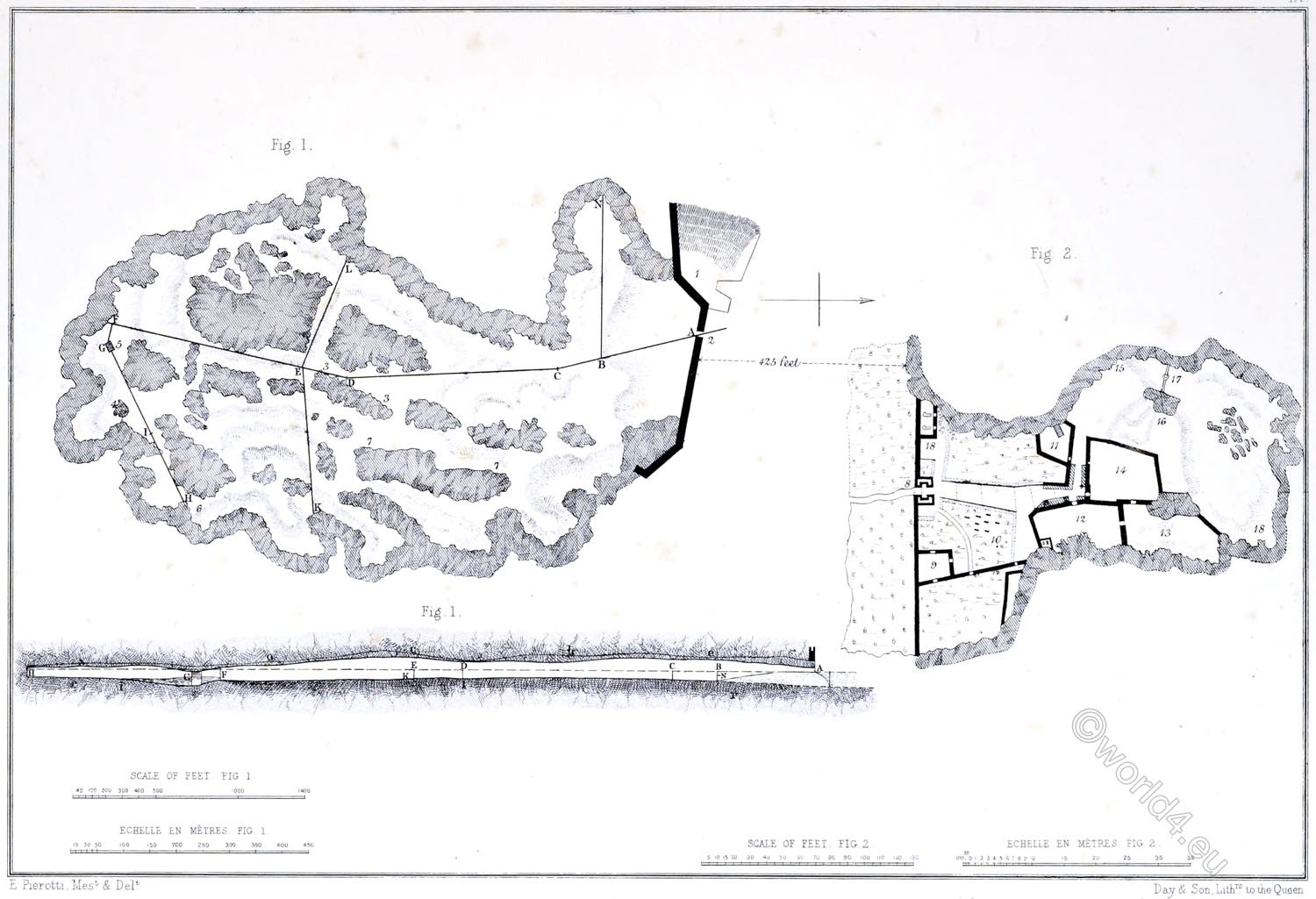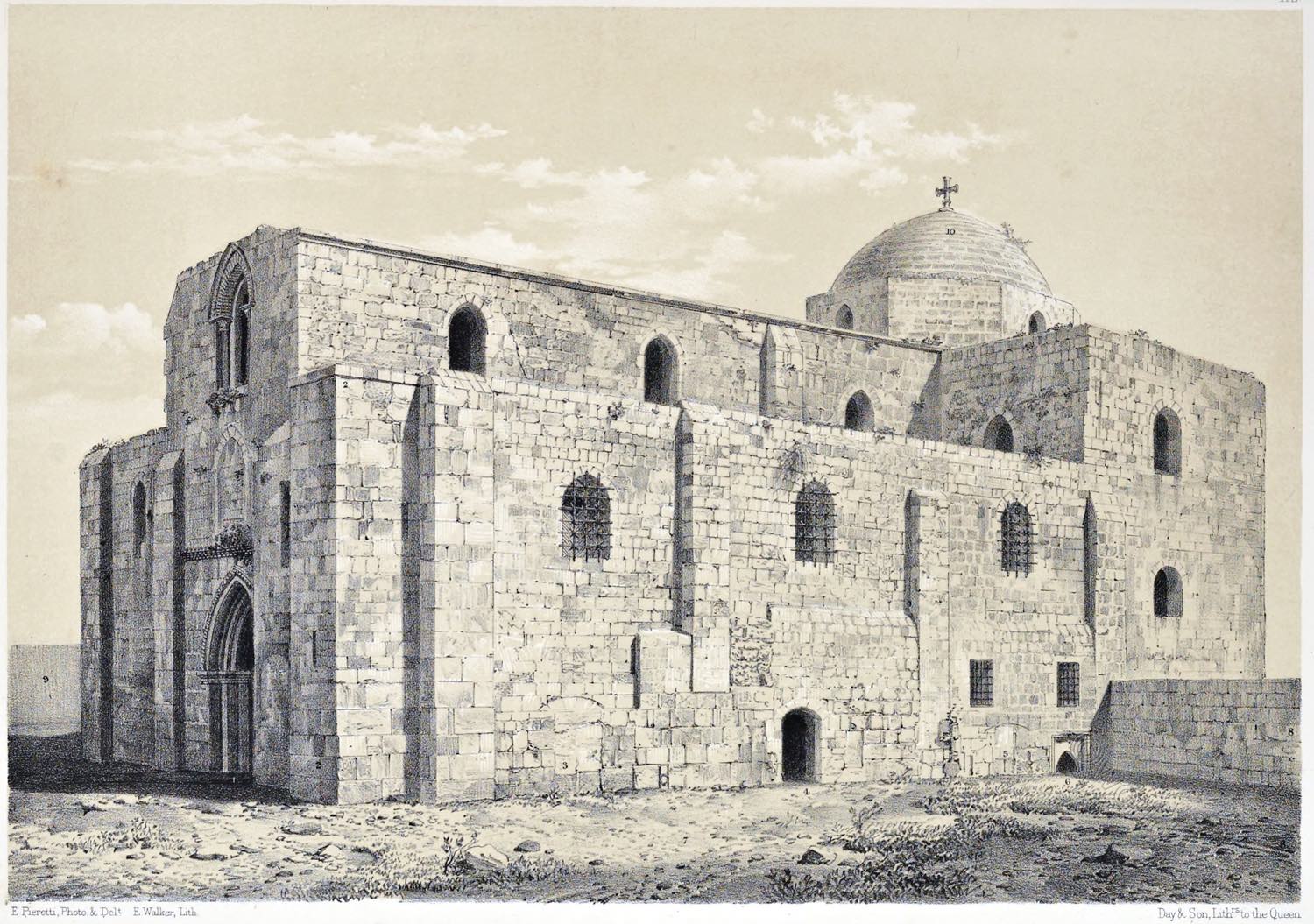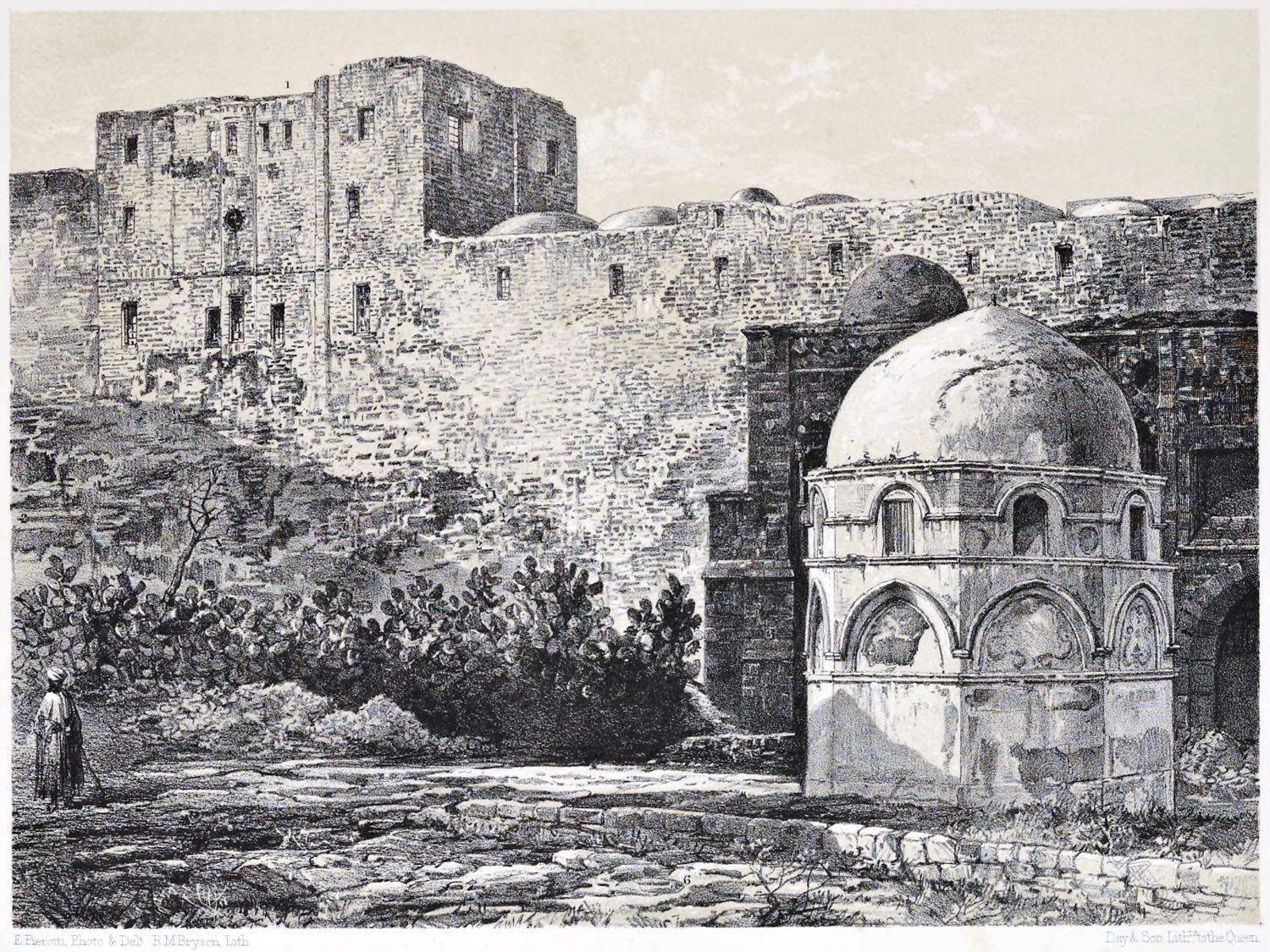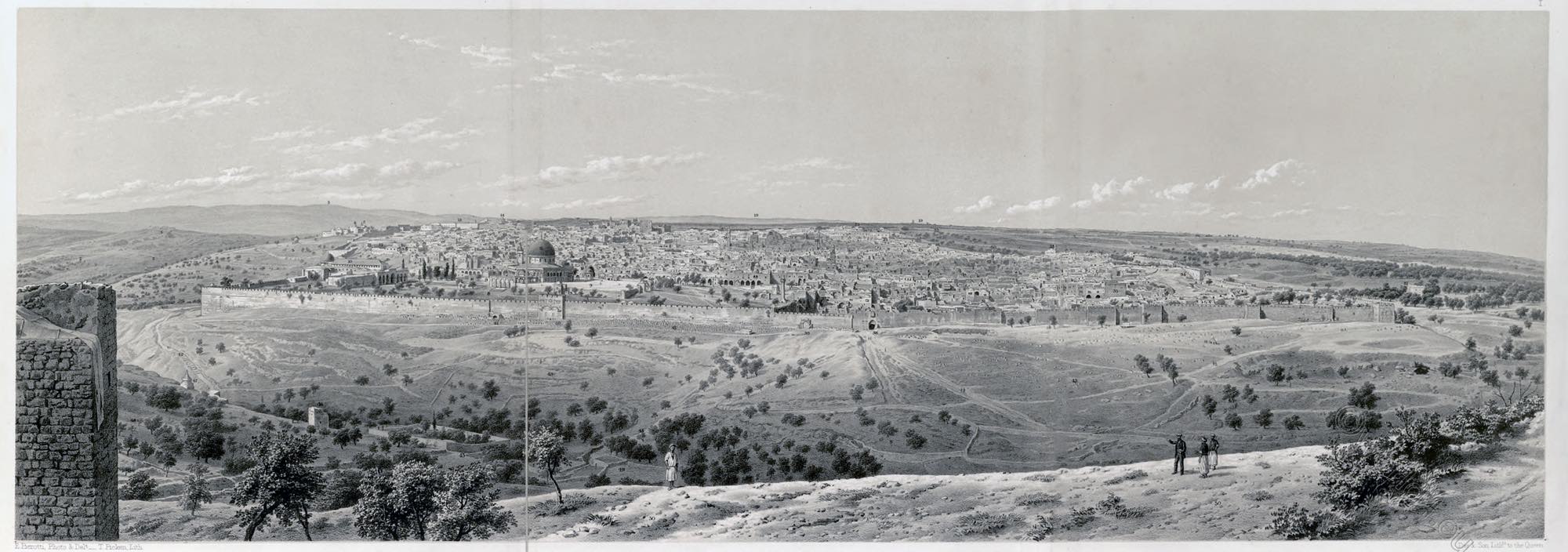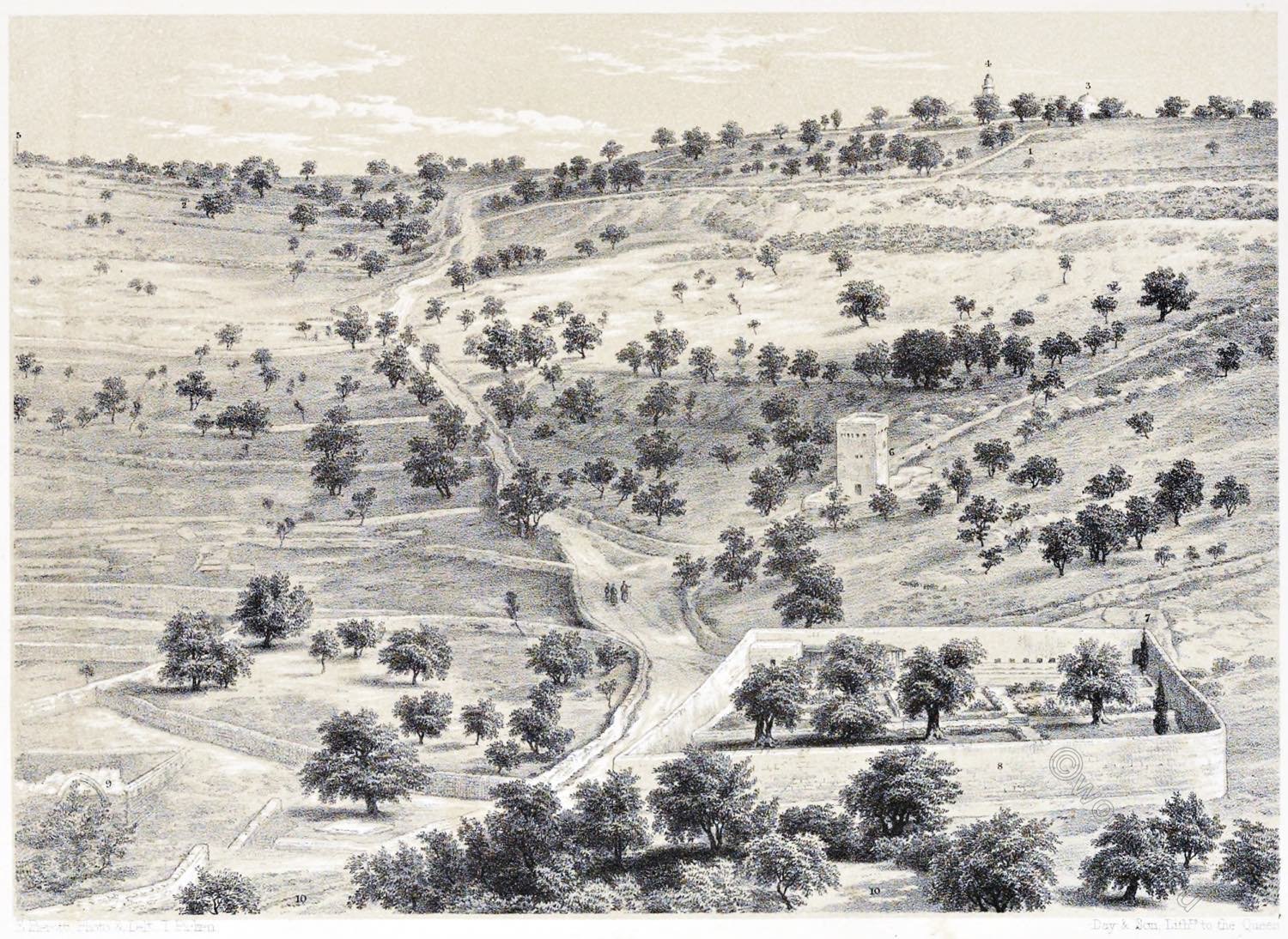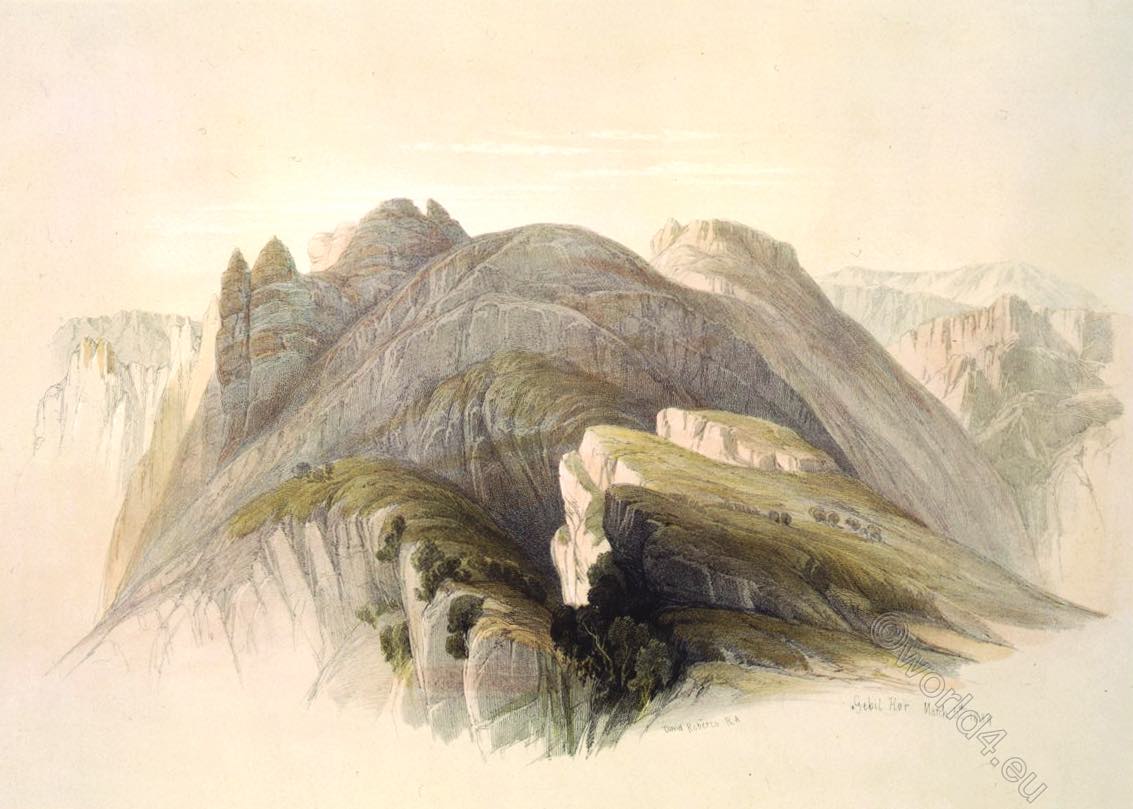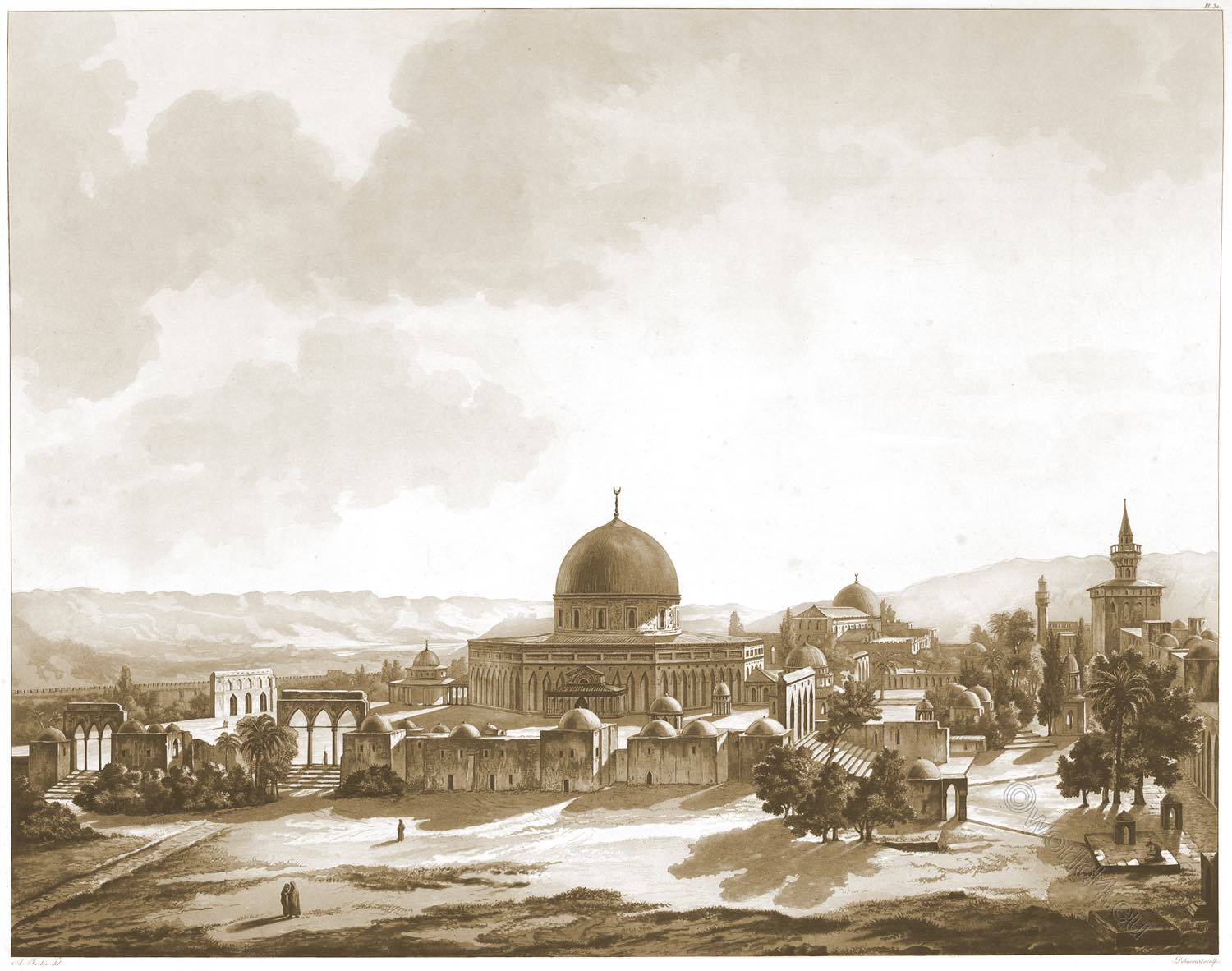
Content:
- View of the south gate of the Haram es-Sherif (Bab el-Huldah).
- Western view of al-Aksa, near the southwestern angle.
- Wailing-place of the Jews. A portion of the ancient wall of the temple enclosure.
- The facade of the mosque Al-Aqsa (Arabic:المسجد الاقصى “the Farthest Mosque”) also known as Bayt al-Muqaddas.
- Section of the mosque of El-Aksa, and of its substructions.
- Underground works of the Mosque of Al-Aqsa, the monolith in the underground works.
- North-eastern view of Kubbet es-Sakharah, and of Kubbet es-Silsileh.
- Section of Kubbet es-Sakharah – view of the interior of the Golden Gate.
- Four mosaics in the interior of Kubbet es-Sakharah (Dome of the Rock), and Mosque al-Aqsa.
- Details of the capital of the monolith in the underground works of Al-Aksa, of the ornamentation of the Golden Gate, and of the six capitals which crown the columns of the mosques.
The Temple Mount in the Old City of Jerusalem. Plans and sections
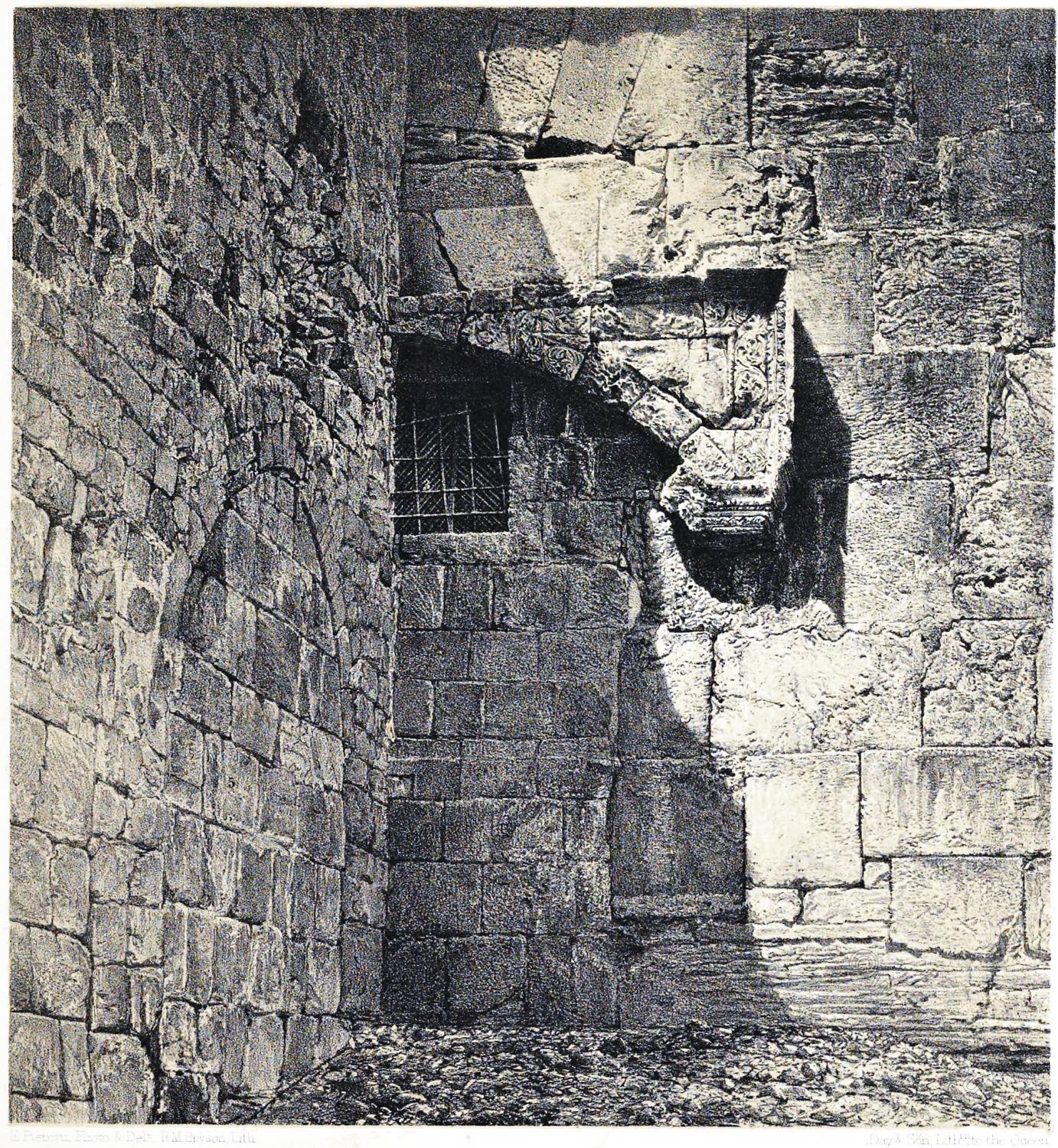
PLATE XX.
VIEW OF THE SOUTH GATE OF THE HARAM ES-SHERIF, (BAB EL-HULDAH.)
- Ornaments of the time of Justinian.
- Inverted Inscription of Antoninus Pius.
- Window through which the Underground Gallery can be seen.
- Huldah Gate, closed.
- Gate of the time of the Crusaders, closed.
- Wall of the time of Justinian.
- Ophel.
The Temple Mount (Arabic الحرم الشريف al-haram ash-scharif ‘the noble sanctuary’) is a hill in the southeast of the Old City of Jerusalem, above the Kidron Valley. On its summit is an artificial plateau of about 14 ha, in the centre of which stood the Herodian Temple, a successor building to the post-exilic Jewish Temple, which in turn was built on the foundations of Solomon’s Temple. The Dome of the Rock has stood here since the 7th century AD. On the southern side of the Esplanade is the al-Aqsā Mosque. The Temple Mount is one of the most controversial holy places in the world.
The Temple Mount in Jerusalem can be entered through eleven gates. In addition, there are six locked gates.
The Gates of Huldah (Hebrew: שערי חולדה, Sha’arei Huldah) were gates leading to the Temple compound in Jerusalem in the Hasmonean period, named in the Mishnah. The term is now used for the remains of two later sets of gates, the Triple Gate and the Double Gate, built as part of the extension of the Temple Mount initiated by Herod.
Both sets of gates were part of the South Wall that bordered the Temple Mount esplanade. From the gates there was access to underground ramps with vaulted ceilings, which led up to the esplanade. They were bricked up in the Middle Ages.
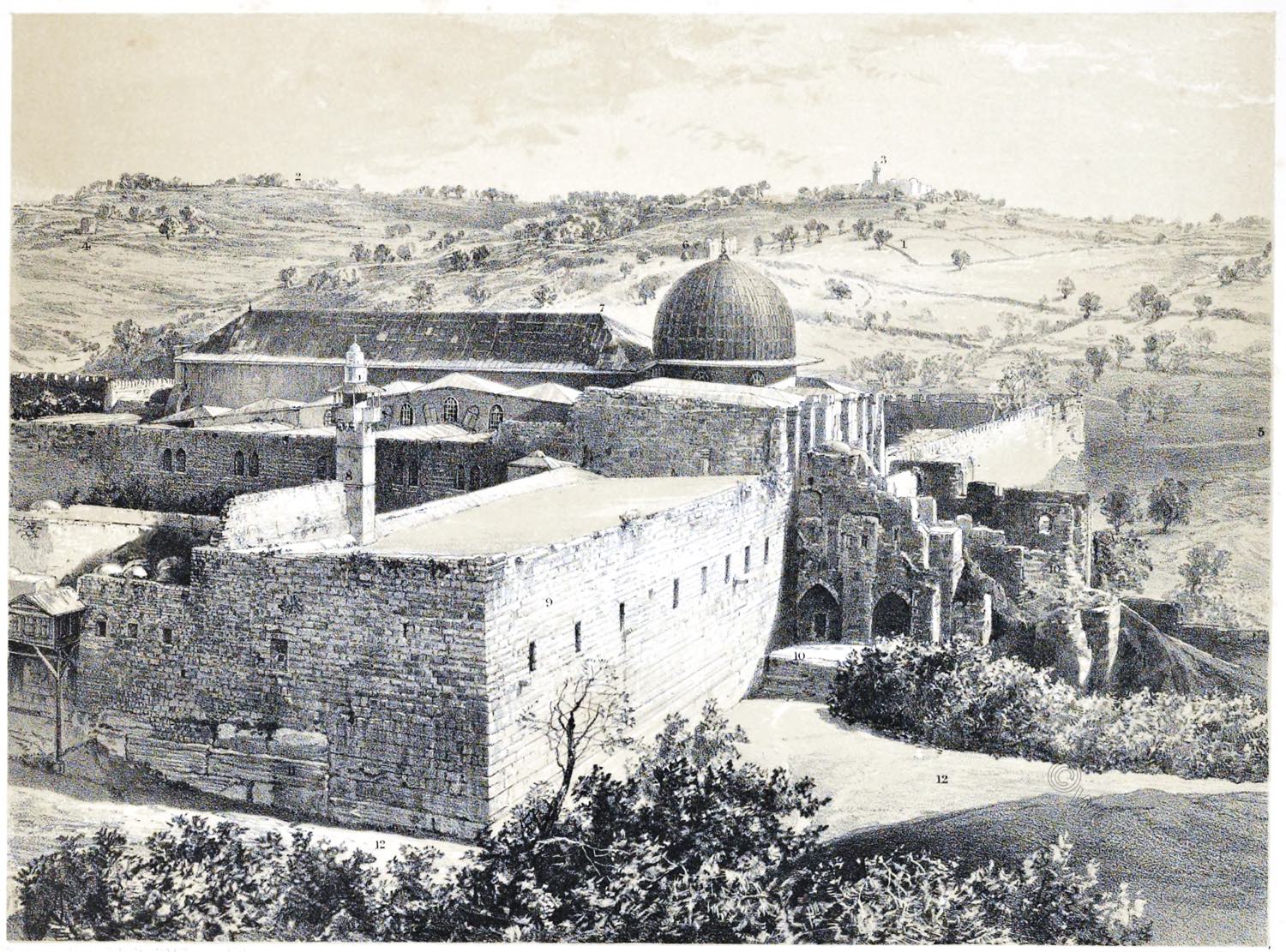
PLATE XXI.
WESTERN VIEW OF AL-AKSA, NEAR THE SOUTHWESTERN ANGLE.
- Mount of Olives. The Mount of Olives in Jerusalem is an elevation northeast and east of the Temple Mount and the Old City of Jerusalem.
- Mount Viri-Galilaei, Church on Mount of Olives.
- Mosque of the Ascension of Jesus Christ. The Ascension Chapel is located on the highest point of the Mount of Olives in Jerusalem, east of the Old City. It is located on the spot from which – according to tradition – Jesus Christ ascended to heaven.
- Arab Tower.
- Mount of Offence also Mount of Corruption (Batn al Hawa).
- Place where Jesus wept over Jerusalem.
- Mosque al-Aksa. The al-Aqsa Mosque is a mosque on the Temple Mount in Jerusalem’s Old City. It is considered the third most important mosque in Islam after the al-Harām Mosque with the central sanctuary of the Kaaba in Mecca and the Prophet’s Mosque with the tomb of the Islamic prophet Mohammed in Medina. Four minarets belong to the mosque. In the area of the mosque stood the Herodian Temple, which King Herod had built around 20 BC and which was destroyed by the Romans under Titus in 70 AD during the Jewish War. Today, only the western retaining wall, the so-called Wailing Wall, remains of the Temple.
- Minaret of the Mogarabins.
- Mosque of Abu-Bekr: Wall of the period of the Crusades.
- Arab Ruins.
- The Bridge, according to Dr Robinson.
- Tyropoeon Valley (Valley of the Cheesemakers). The Tyrepeon Valley is the name given by the historian Flavius Josephus to a steep ravine located in the Old City of Jerusalem, which in ancient times separated Mount Moriah from Mount Zion and flowed into the valley of Hinnom. Tyropeon is now covered by a large accumulation of debris and is almost a plain: in ancient times, however, it was crossed by bridges, the best known of which was the Zion Bridge, an ordinary means of linking the Royal Palace and the Temple.
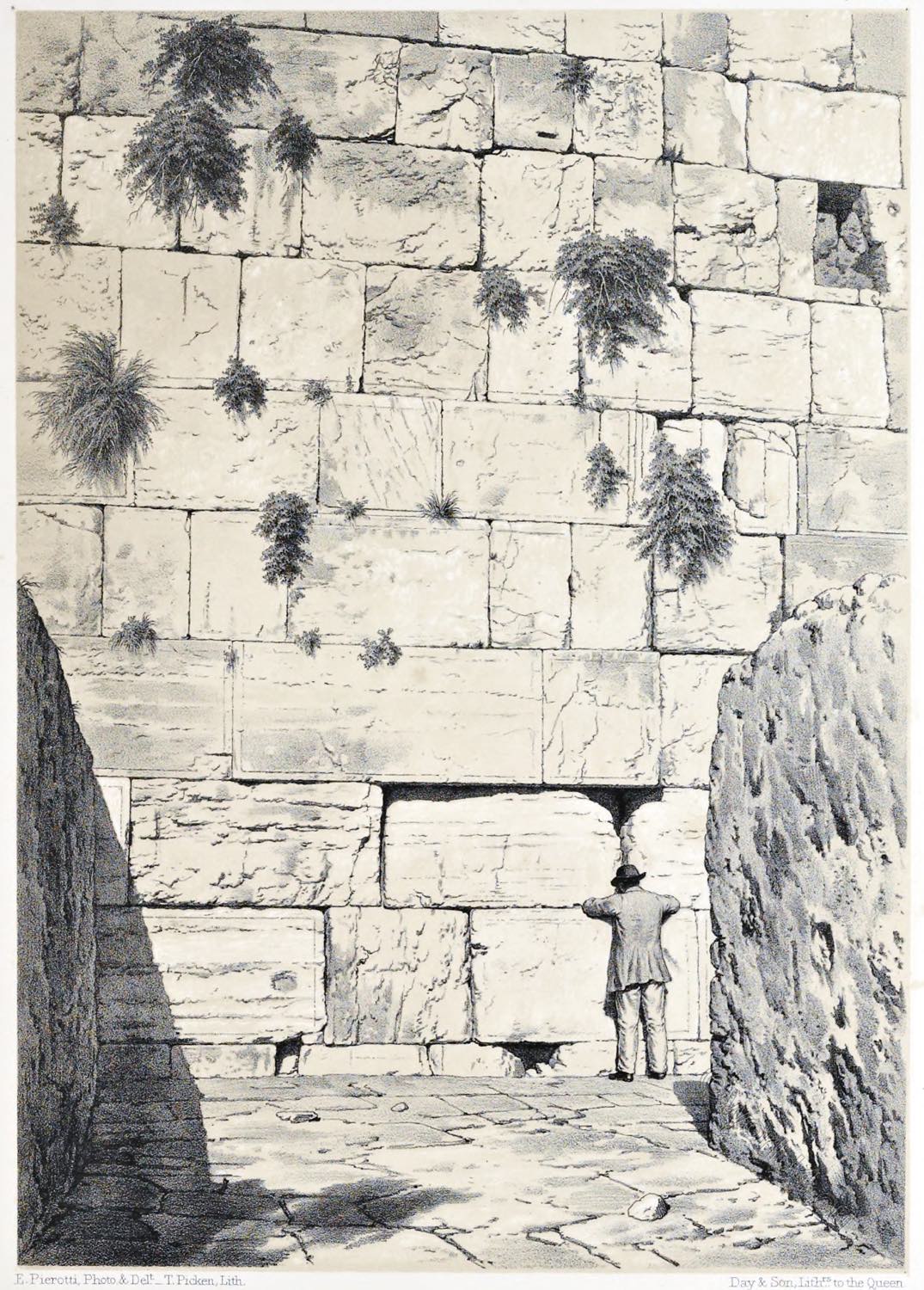
PLATE XXII.
WAILING·PLACE OF THE JEWS. A PORTION OF THE ANCIENT WALL OF THE TEMPLE ENCLOSURE.
This Wall is of the date of Herod the Great, and is the best specimen of the Masonry of that period to be found in Jerusalem. The Jews come to pray and weep before it every Friday.
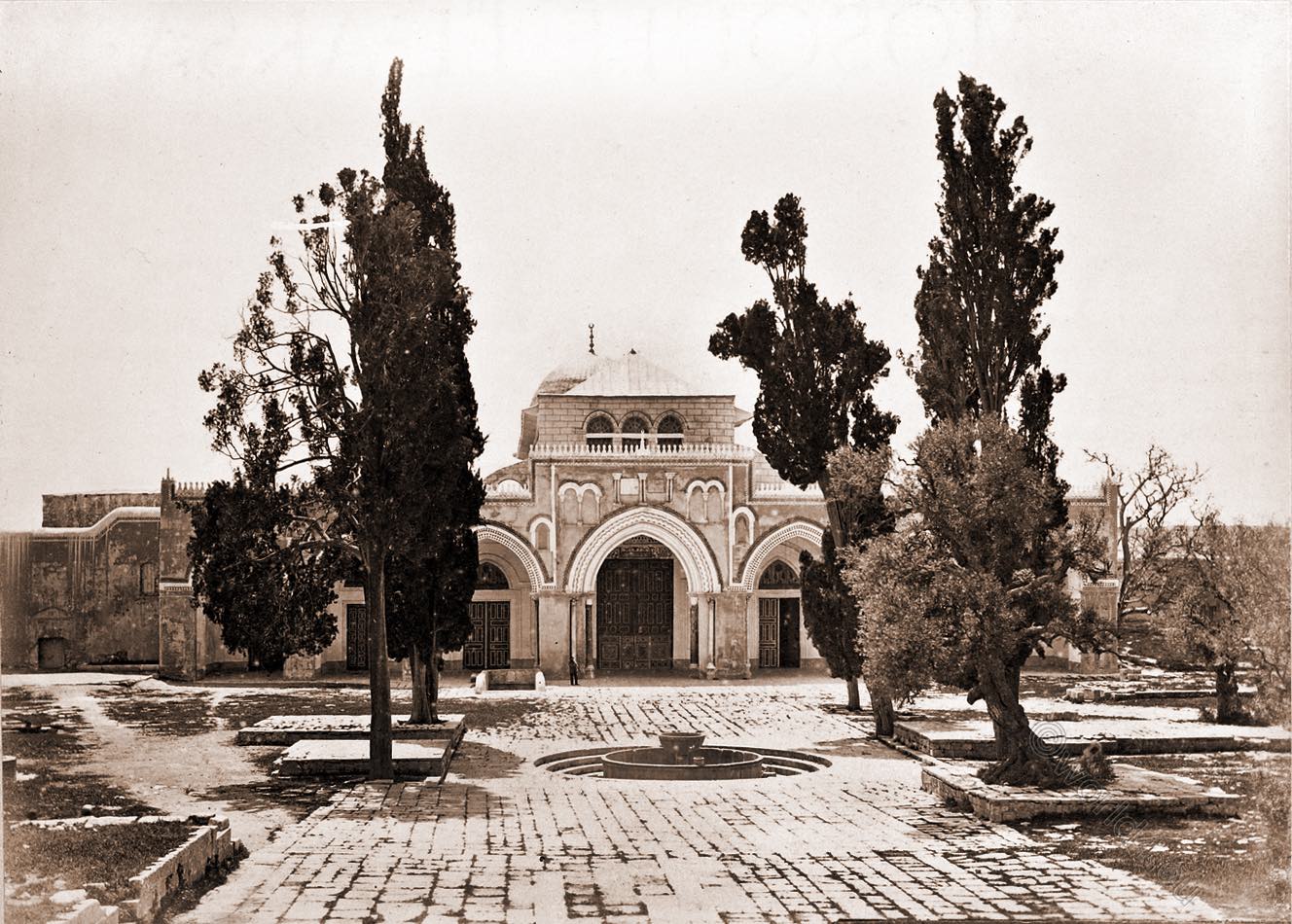
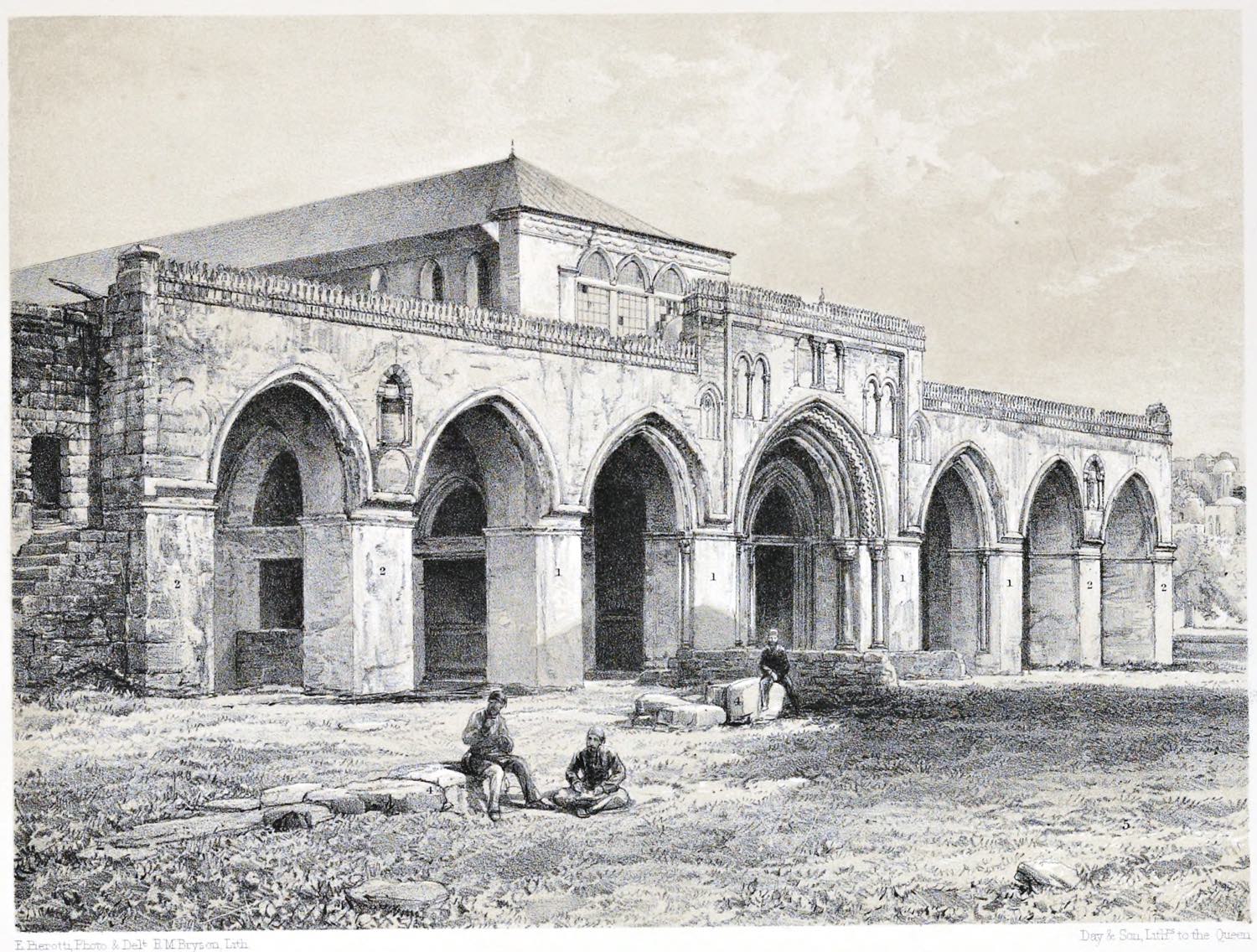
PLATE XXIII.
FACADE OF THE MOSQUE AL-AKSA.
- Ancient Piers.
- Piers of a much later date.
- Steps leading to a Storehouse.
- Opening into the Cistern Birket es-Sultan.
- Haram es-Sherif
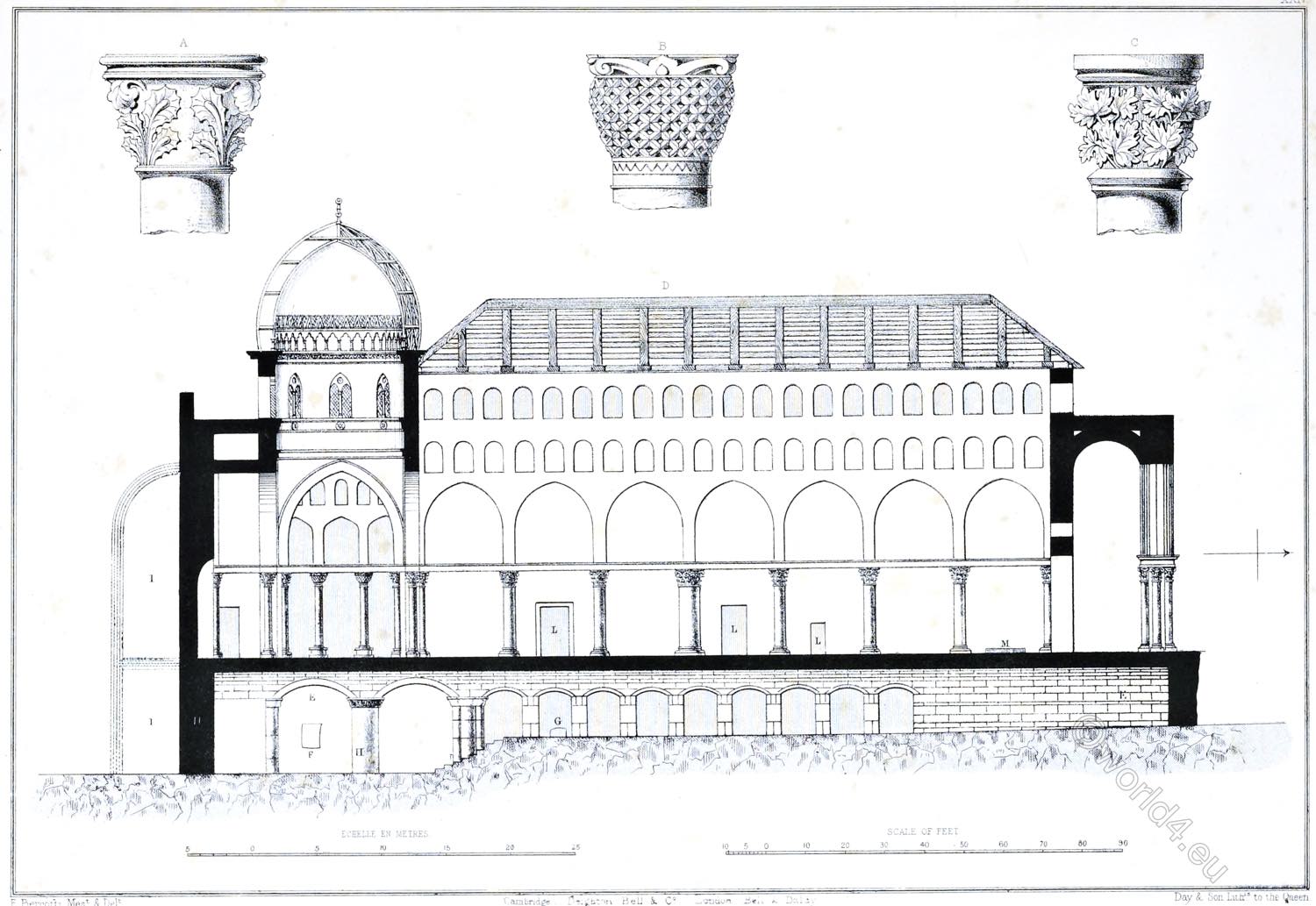
PLATE XXIV.
SECTION OF THE MOSQUE OF EL-AKSA, AND OF ITS SUBSTRUCTIONS.
- Position of the Ancient Choir, thrown down by an earthquake.
- Ancient Jewish Wall.
A. B. C. Capitals found by Pierotti,
D. Wooden Roof of the Mosque el-Aksa.
E. Wall of the time of Justinian.
F. Aperture in the Wall leading to Subterranean Passage on the West.
G. Walled-up Door.
H. Monolith.
L. Side-doors of the Mosque.
M. Tombs of Aaron’s Sons, according to Mohammedan traditions.
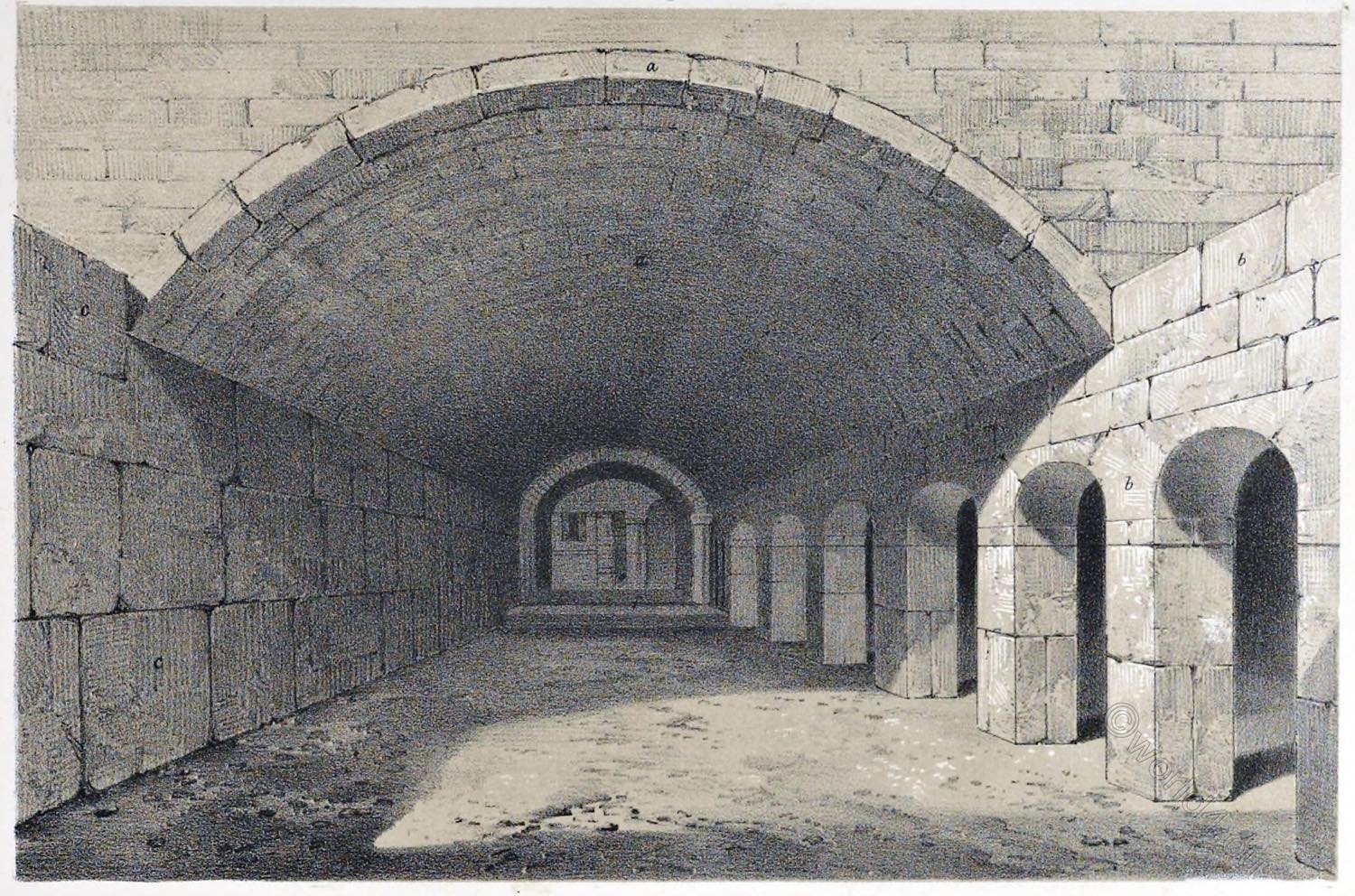
PLATE XXV.
UNDERGROUND WORKS OF THE MOSQUE OF AL-AQSA. THE MONOLITH IN THE UNDERGROUND WORKS.
Fig. I. Underground Works.
a. Vaulted underground Works, originally Jewish building. Restoration by Justinian (as shewn by Rev. G. Williams).
b. Pillars of the time of Justinian.
c. Wall erected by Justinian.
f Monolith.
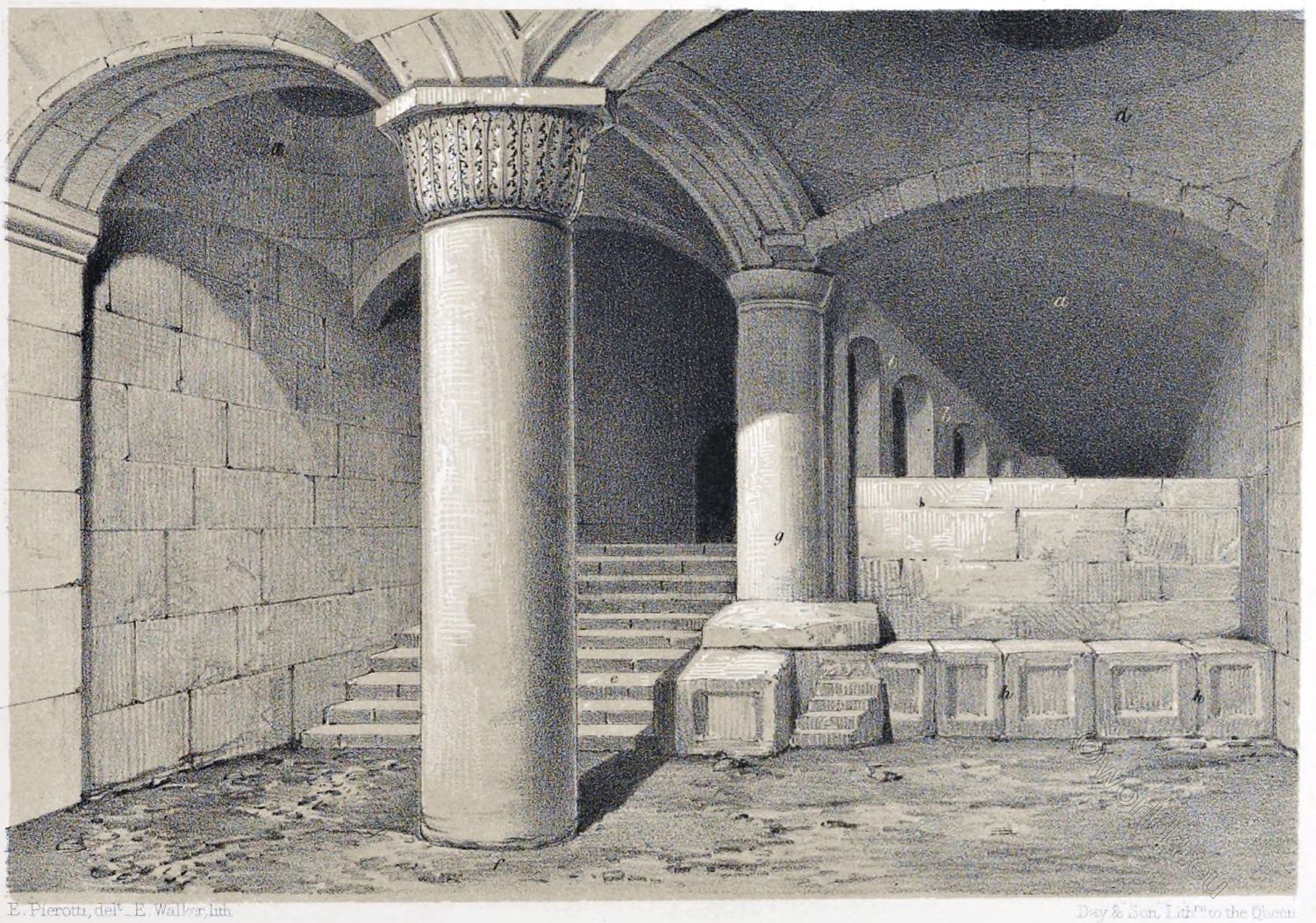
Fig. 2. Monolith.
d. Dome vaulting of the time of Justinian.
e. Staircase resting on the Rock.
f. Monolith.
g. Smaller Monolith.
h. Rusticated Stones of the time of Herod.
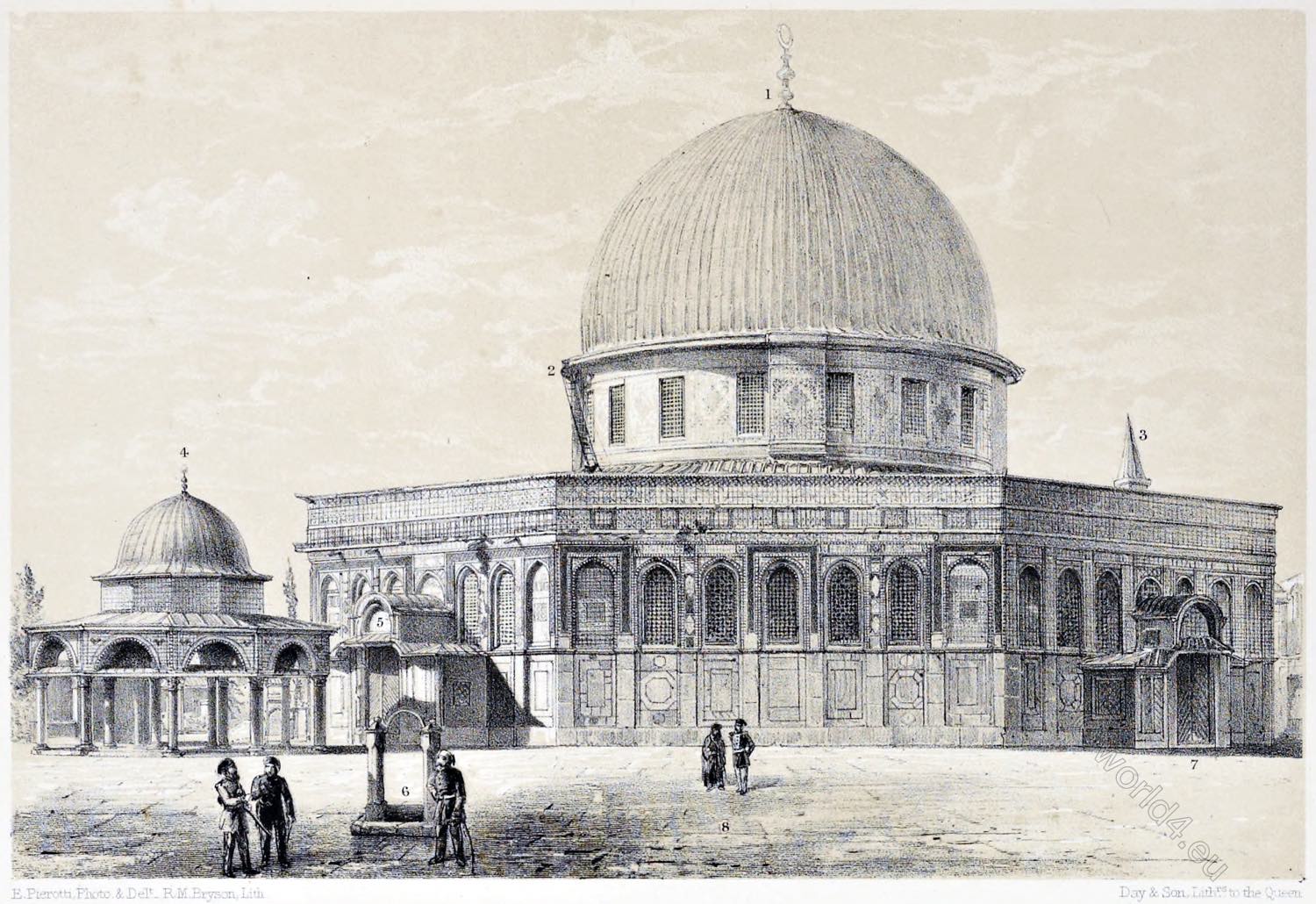
PLATE XXVI.
NORTH-EASTERN VIEW OF KUBBET ES-SAKHARAH, AND OF KUBBET ES-SILSILEH.
- Mosque Kubbet es-Sakharah.
- Ladder used by Pierotti for his observations.
- Minaret of Kadhi.
- Kubbet es-Silsileh, Dome of the Chain.
- Bab el-Daud, David’s Gate.
- Cistern (the Place of the Ashes).
- Bab el-Jenni, Gate of Paradise.
- Mount Moriah (anciently the Threshing-floor of Araunah).
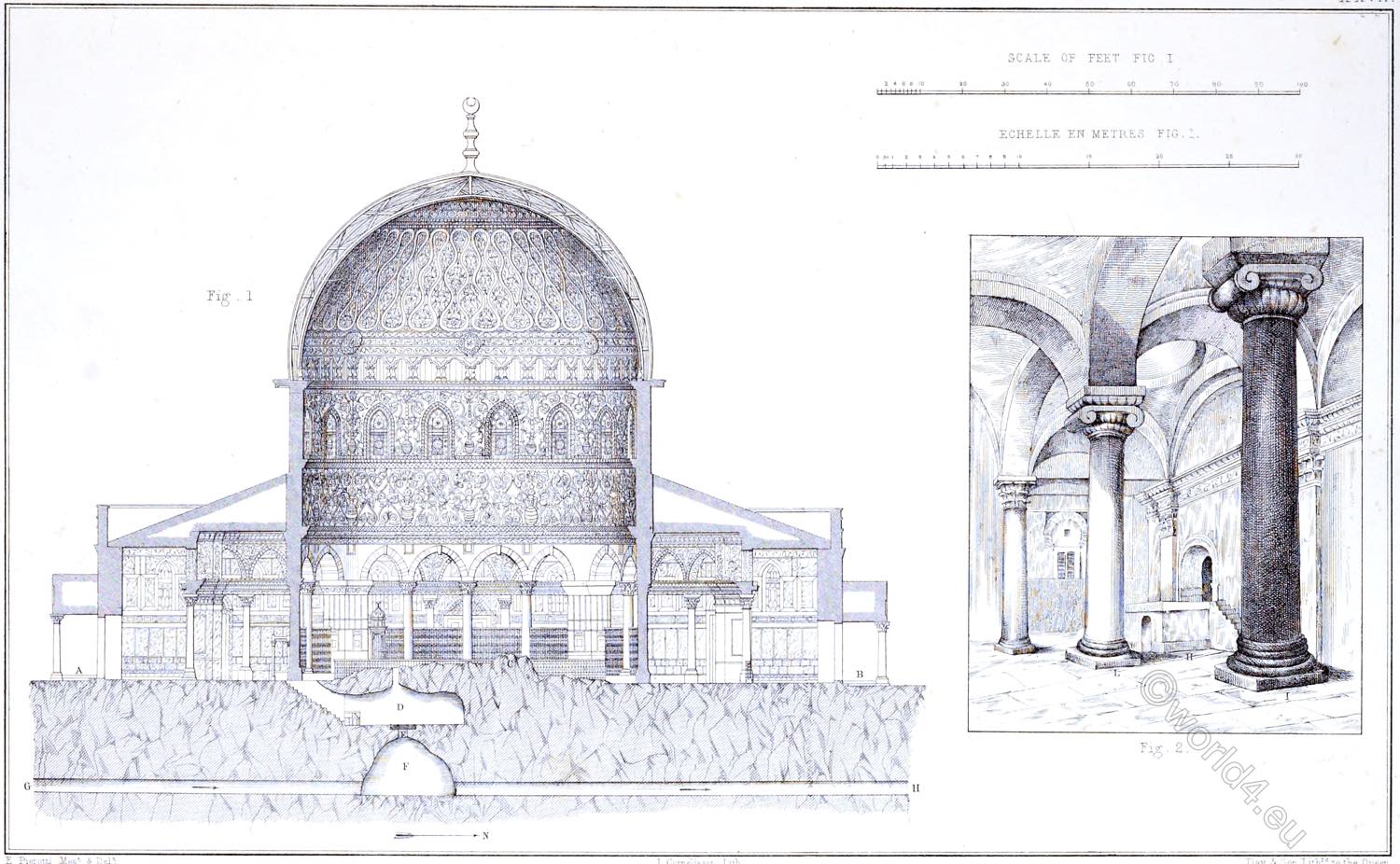
PLATE XXVII.
SECTION OF KUBBET ES-SAKHARAH – VIEW OF THE INTERIOR OF THE GOLDEN GATE.
Fig. I. Kubbet es-Sakbarab.
A. Bab el-Kibli, Gate of Prayer.
B. Bab el-Jenni, Gate of Paradise.
C. Threshing-floor of Araunah tbe Jebusite.
D. Upper Chamber of the Cistern of the Threshing-floor of Araunah the Jebusite.
E. Hole now covered with a stone.
F. Lower Chamber of tbe Cistern of the Threshing-floor of Araunah the Jebusite.
G. Water-Conduit.
H. Conduit for Blood.
Fig. 2. Golden Gate.
H. Modern Arabic Construction.
I. Marble Pillar, Monolith.
L. Marble Pillar, Monolith.
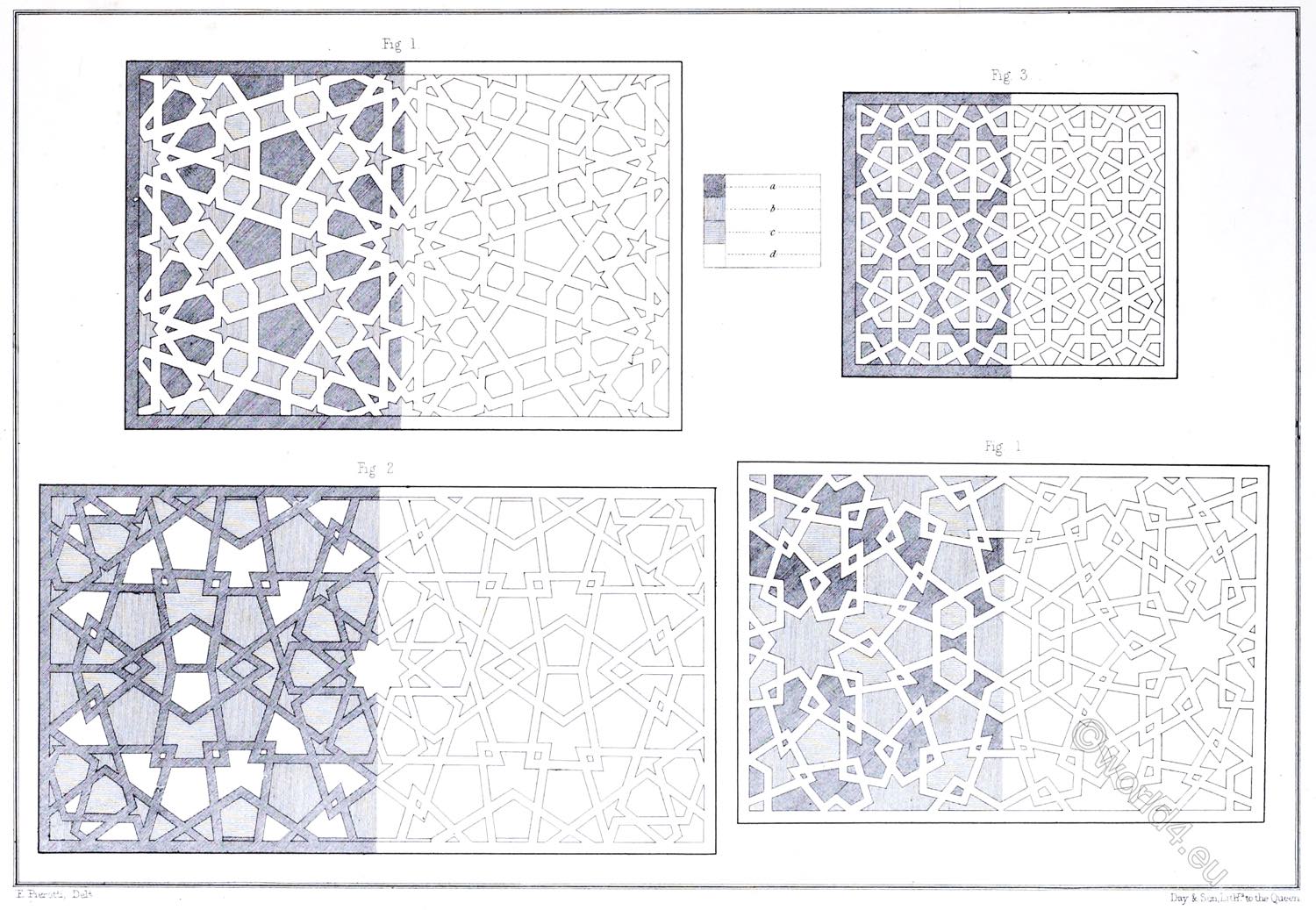
PLATE XXVIII.
FOUR MOSAICS IN THE INTERIOR OF KUBBET ES-SAKHARAH, AND MOSQUE AL-AQSA.
Fig. 1. Interior of Kubbet es-Sakharah.
Fig. 2. Interior of Mosque al-Aqsa.
Fig. 3. Interior of Mosque al-Aqsa.
Fig. 4. Interior of Kubbet es-Sakharah,
a. Red.
b. Yellow.
c. Black.
d. White.
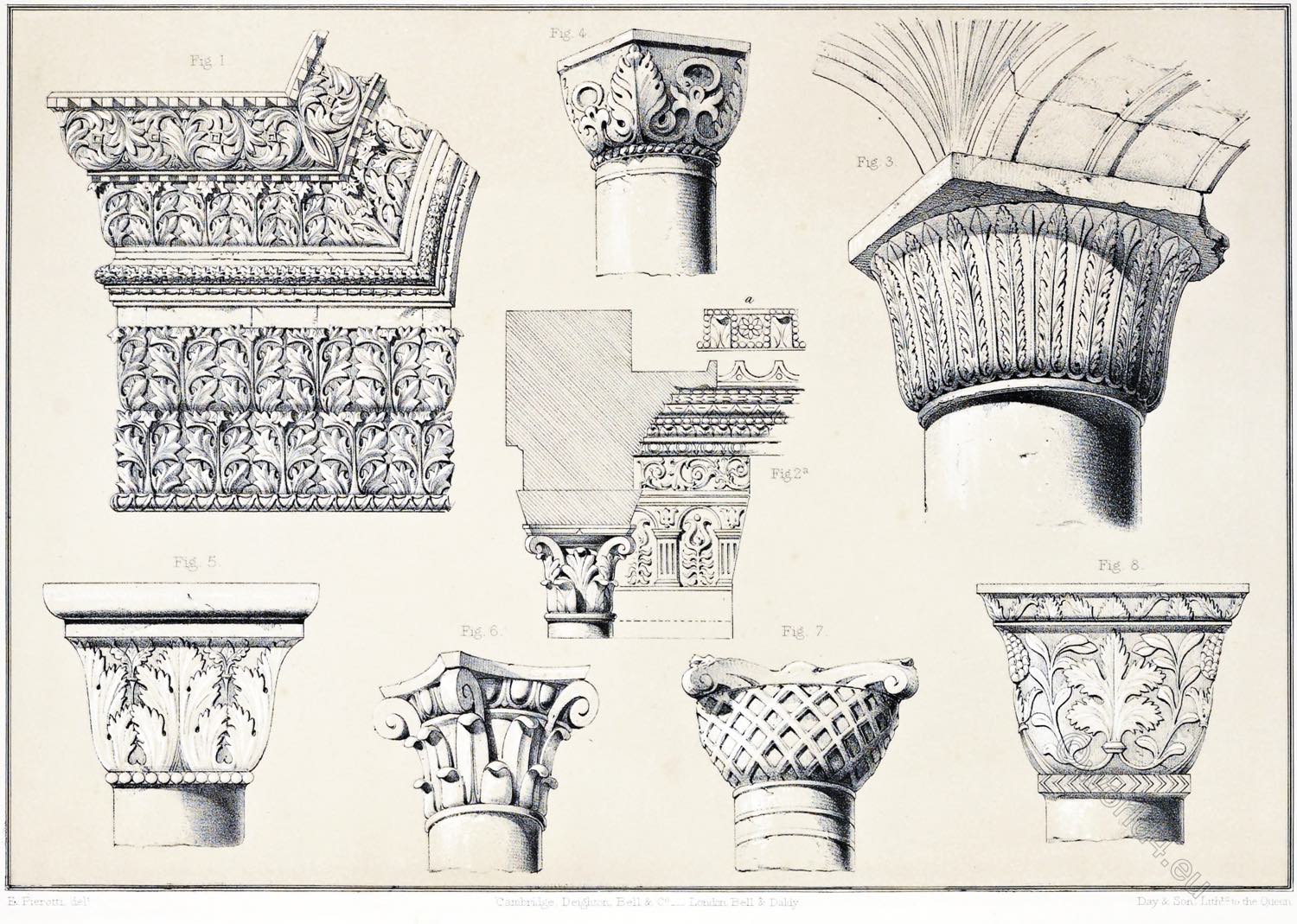
PLATE XXIX.
DETAILS OF THE CAPITAL OF THE MONOLITH IN THE UNDERGROUND WORKS OF AL-AKSA; OF THE ORNAMENTATION OF THE GOLDEN GATE; AND OF THE SIX CAPITALS WHICH CROWN THE COLUMNS OF THE MOSQUES.
Fig. 1. Ornamentation of the Golden Gate.
Fig. 2. Capital in the Kubbet es-Sakharah. (a). Ornamentation in the Kubbet es-Sakharah.
Fig. 3. Capital of the Monolith.
Fig. 4. Capital in the Gate of Huldah.
Fig. 5. Capital found among rubbish in the vaults in the South-eastern corner of the Haram es-Sherif
Fig. 6. Capital in the Kubbet es-Sakbarah.
Fig. 7. Capital in the Mosque al-Aksa.
Fig. 8. Capital found among rubbish in the vaults in the South-eastern corner of the Haram es-Sherif.
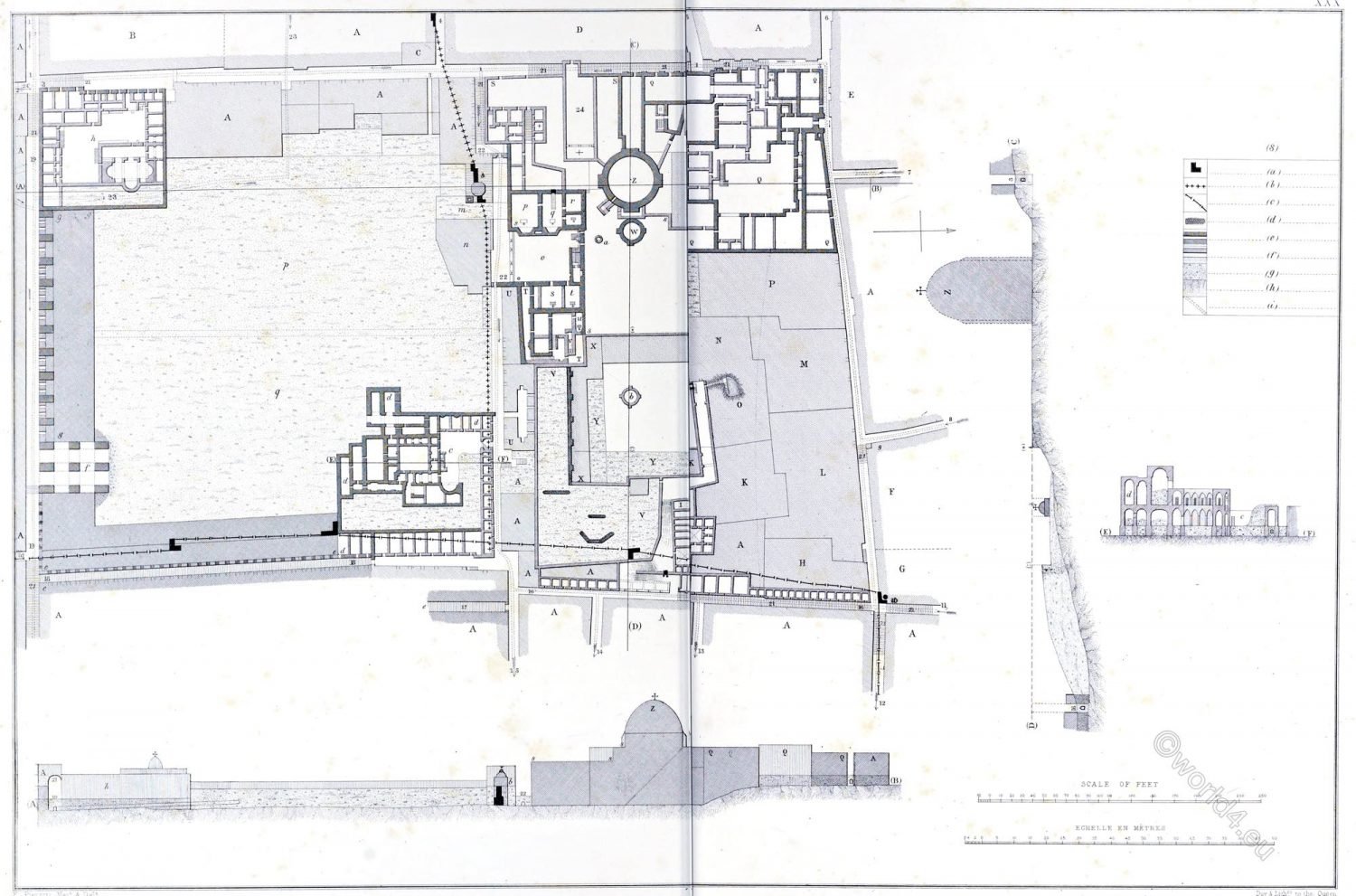
PLATE XXX.
The Temple Mount.
PLAN AND SECTION OF LAND SURROUNDING THE CHUROH OF THE RESURRECTION AND THE HOSPITAL OF THE KNIGHTS OF S. JOHN.
A. Ordinary Native Houses.
B. Greek House of the Convent of S. John.
C. Private Greek House.
D. Greek Convent of S, Constantine.
E. Greek House of the Convent of S. Constantine.
F. Greek Convent of S. Cbaralampes.
G. Latin House.
H. Prussian House.
I. Mohammedan House.
K. Latin House called that of the Prince.
L. Greek Convent of S. Charalampes.
M. Ancient House of the Canons of the Holy Sepulchre.
N. Coptic Convent.
O. Cistern of S. Helena belonging to the Copts.
P. Ancient House of the Canons of the Holy Sepulchre.
Q. Ancient Hospice of Saladin (el-Kanki).
R. Latin Convent of the Church of the Resurrection.
S. Terrace-roof of the Greek Convent of S. Constantine.
T. Greek Convent of S. Abraham.
U. Greek Houses.
V. Land belonging to the Russian Consulate on the Site of the Church of S. Mary Latin.
X. Convent of the Abyssinians.
Y. Land of tbe Abyssinians.
Z. Dome of the Church of the Resurrection.
W. Greek Dome of the Church of the Resurrection.
a. Dome of the Golgotha.
b. Dome of the Chapel of S. Helena.
c. Ruins of the Church of S. Mary the Great.
d. Land formerly belonging to the Convent of S. Mary the Great.
e. Ancient Bazaar.
f. Corn Market.
g. Ancient Bazaar of the Street of David.
h. Greek Convent of S. John Baptist,
l. Lesser Mosque of Omar. Ancient Jewish Walls.
m. Minaret of Omar.
n. Greek Convent dependent all the Church of Gethsemane.
o. Vestibule of the Church of the Resurrection.
p. Ground anciently belonging to the Knights of S. John.
q. Land formerly belonging to the Convent of S. Mary the Great.
p. q. Greek Chapels.
r. Tower of the Church of the Resurrection.
s. Armenian Chapel of S. J obu.
t. Coptic Chapel.
u. Greek Chapel of Melchizedek.
v. Greek Chapel.
- Street to Jaffa Gate.
- Street of Mount Sion (Zion).
- Christian Bazaar.
- Street of Coptic Hospice.
- Street of Greek Convent of S. Constantine.
- Street of Latin Convent of S. Saviour .
- Street to the North.
- Street to Residence of the Spanish Consul.
- Greek Convent of S. Charalampes (Saint Charalambos), where Jesus met the Daughters of Jerusalem.
- Gabe of Judgement) with an ancient pillar: second Fall of Jesus.
- Street to Damascus Gate.
- Via Dolorosa.
- Street to Hospital of S. Helena.
- &
- Street of Tyropoaon Valley.
- Street from Damascus Gate to Bazaar.
- &
- Covered Bazaar.
- Street of David.
- Street to Sion Gate.
- Arches.
- Street to Church of the Resurrection.
- Sewer of Amygdalon.
- Sewer of English Church.
(S). Conventional Signs.
(a). Ancient Jewish Walls.
(b). Hezekiah’s Wall according to Pierotti.
(c). Second Wall of the time of Solomon according to Pierotti.
(d). Walls of the time of Amalfi Merchants .
(e). Walls of the time of S. Helena, of the Crusaders, and of Saladin.
(f). Modern Arab Walls.
(g). Place covered by Ruins and Earth.
(h). Rock.
(i). Sewers.
Source:
- Jerusalem Explored. Being a description of the ancient and modern city, with numerous illustrations consisting of views, ground plans, and sections by Ermete Pierotti; translated by Thomas George Bonney (Fellow of St Johns College, Cambridge). London: Bell and Daldy; Cambridge: Deighton, Bell and Co. 1864.
- Souvenirs d’Orient: album pittoresque des sites, villes et ruines les plus remarquables de la Terre-Sainte, par Félix Bonfils (1831-1885). A Alais (Gard): Chez l’auteur, 1878.
- Voyage dans le Levant by Louis Nicolas Philippe Auguste comte de Forbin (1777-1841). Paris: De l’Imprimerie royale, 1819.
Continuing
Discover more from World4 Costume Culture History
Subscribe to get the latest posts sent to your email.

